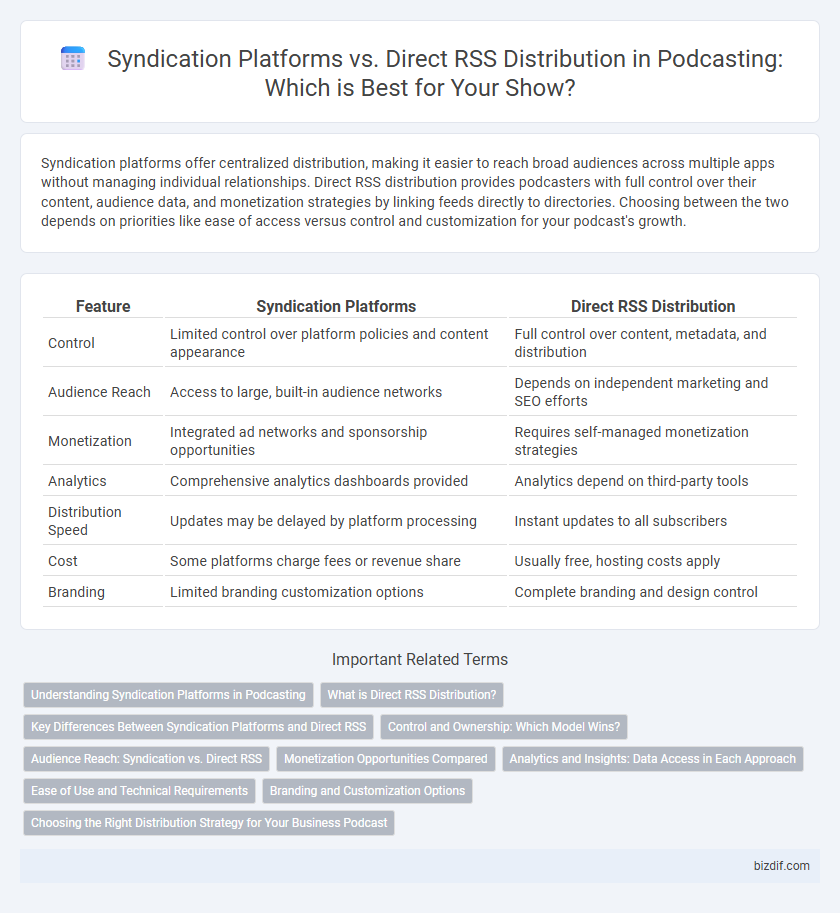Syndication platforms offer centralized distribution, making it easier to reach broad audiences across multiple apps without managing individual relationships. Direct RSS distribution provides podcasters with full control over their content, audience data, and monetization strategies by linking feeds directly to directories. Choosing between the two depends on priorities like ease of access versus control and customization for your podcast's growth.
Table of Comparison
| Feature | Syndication Platforms | Direct RSS Distribution |
|---|---|---|
| Control | Limited control over platform policies and content appearance | Full control over content, metadata, and distribution |
| Audience Reach | Access to large, built-in audience networks | Depends on independent marketing and SEO efforts |
| Monetization | Integrated ad networks and sponsorship opportunities | Requires self-managed monetization strategies |
| Analytics | Comprehensive analytics dashboards provided | Analytics depend on third-party tools |
| Distribution Speed | Updates may be delayed by platform processing | Instant updates to all subscribers |
| Cost | Some platforms charge fees or revenue share | Usually free, hosting costs apply |
| Branding | Limited branding customization options | Complete branding and design control |
Understanding Syndication Platforms in Podcasting
Syndication platforms in podcasting serve as centralized hubs that distribute episodes to multiple directories, streamlining the publishing process and enhancing discoverability across apps like Apple Podcasts, Spotify, and Google Podcasts. These platforms offer advanced analytics, monetization options, and audience engagement tools that direct RSS distribution often lacks. By leveraging syndication platforms, podcasters can efficiently manage content delivery, track listener behavior, and expand their reach without manually submitting their RSS feed to each individual directory.
What is Direct RSS Distribution?
Direct RSS Distribution refers to the process of publishing a podcast's RSS feed directly to various podcast directories and apps without relying on third-party syndication platforms. This method allows podcasters to maintain complete control over their content, metadata, and updates, ensuring immediate changes are reflected across all platforms. Direct RSS Distribution enhances flexibility and reduces dependency on intermediaries, optimizing content delivery and audience reach.
Key Differences Between Syndication Platforms and Direct RSS
Syndication platforms aggregate podcast content, offering discoverability and monetization features, while direct RSS distribution enables podcast creators to maintain full control over content delivery and subscriber data. Syndication platforms often provide analytics, advertising, and cross-promotion opportunities, whereas direct RSS feeds require podcasters to manage hosting, distribution, and tracking independently. Understanding these differences helps podcasters choose between broader audience reach with platform support or autonomous content management and listener engagement.
Control and Ownership: Which Model Wins?
Syndication platforms offer streamlined distribution and audience aggregation but often limit full control over content monetization and analytics. Direct RSS distribution empowers podcasters with complete ownership, enabling independent hosting, customizable user experience, and direct relationship management with listeners. For creators prioritizing autonomy, direct RSS is the preferred model, ensuring maximum control over podcast rights, revenue streams, and data insights.
Audience Reach: Syndication vs. Direct RSS
Syndication platforms amplify audience reach by distributing podcasts across multiple directories like Apple Podcasts, Spotify, and Google Podcasts, ensuring exposure to diverse listener bases with minimal effort. Direct RSS distribution offers control and ownership but requires manual promotion to grow the audience, often limiting reach to existing followers or website visitors. Choosing syndication maximizes discoverability through algorithm-driven recommendations, while direct RSS is ideal for niche content targeting a dedicated listener community.
Monetization Opportunities Compared
Syndication platforms offer enhanced monetization opportunities through built-in ad networks, dynamic ad insertion, and audience analytics, enabling podcasters to optimize revenue streams effectively. Direct RSS distribution provides full control over content and monetization methods but requires more effort for audience growth and ad sales, often resulting in slower revenue scaling. Choosing syndication platforms can accelerate monetization via diversified income models, while direct distribution favors long-term independence with potentially higher earnings per listener.
Analytics and Insights: Data Access in Each Approach
Syndication platforms offer consolidated analytics dashboards that provide detailed insights on listener demographics, engagement metrics, and download trends across multiple directories. Direct RSS distribution grants podcasters full access to raw data, enabling custom analytics through third-party tools but requires technical expertise for data interpretation. Choosing between these methods impacts the depth and control of podcast performance insights available to content creators.
Ease of Use and Technical Requirements
Syndication platforms simplify podcast distribution by handling hosting, RSS feed management, and analytics in a user-friendly interface, requiring minimal technical knowledge. Direct RSS distribution demands more technical skills for creating and managing feeds, but offers full control over content and customization without third-party dependencies. Choosing between the two depends on the creator's comfort with technology and desire for autonomy versus convenience.
Branding and Customization Options
Syndication platforms offer streamlined distribution with limited branding flexibility, often standardizing podcast presentation across apps, which can dilute unique brand identity. Direct RSS distribution empowers podcasters with complete control over feed customization, enabling tailored branding elements such as personalized artwork, episode metadata, and listener engagement features. Leveraging direct RSS feeds enhances brand consistency and listener recognition by maintaining full ownership of content and customization capabilities.
Choosing the Right Distribution Strategy for Your Business Podcast
Choosing the right distribution strategy for your business podcast hinges on understanding the benefits of syndication platforms versus direct RSS distribution. Syndication platforms like Apple Podcasts, Spotify, and Google Podcasts offer broad audience reach, built-in analytics, and user-friendly interfaces, while direct RSS distribution enables greater control over content, monetization, and subscriber data. Evaluating your podcast's goals, audience demographics, and desired level of control will guide you in selecting a strategy that maximizes exposure and returns.
Syndication Platforms vs Direct RSS Distribution Infographic

 bizdif.com
bizdif.com